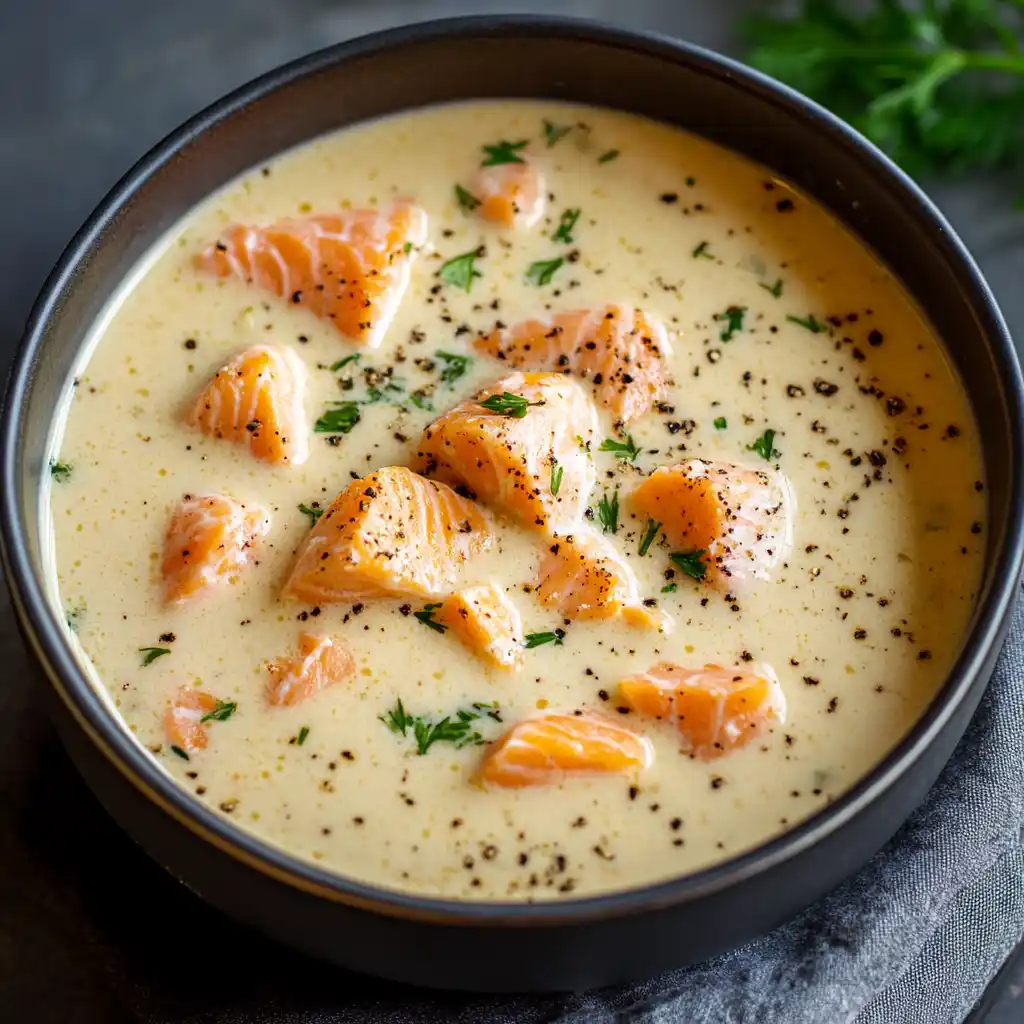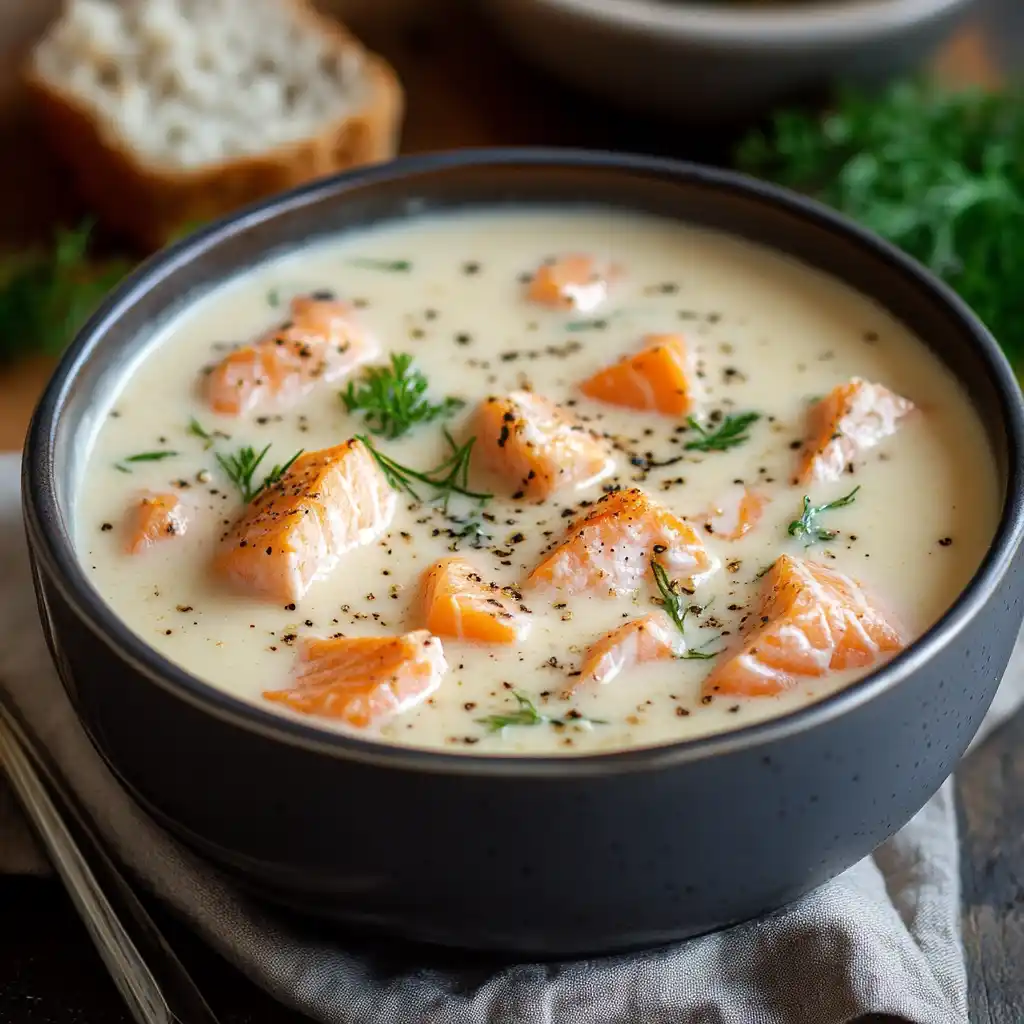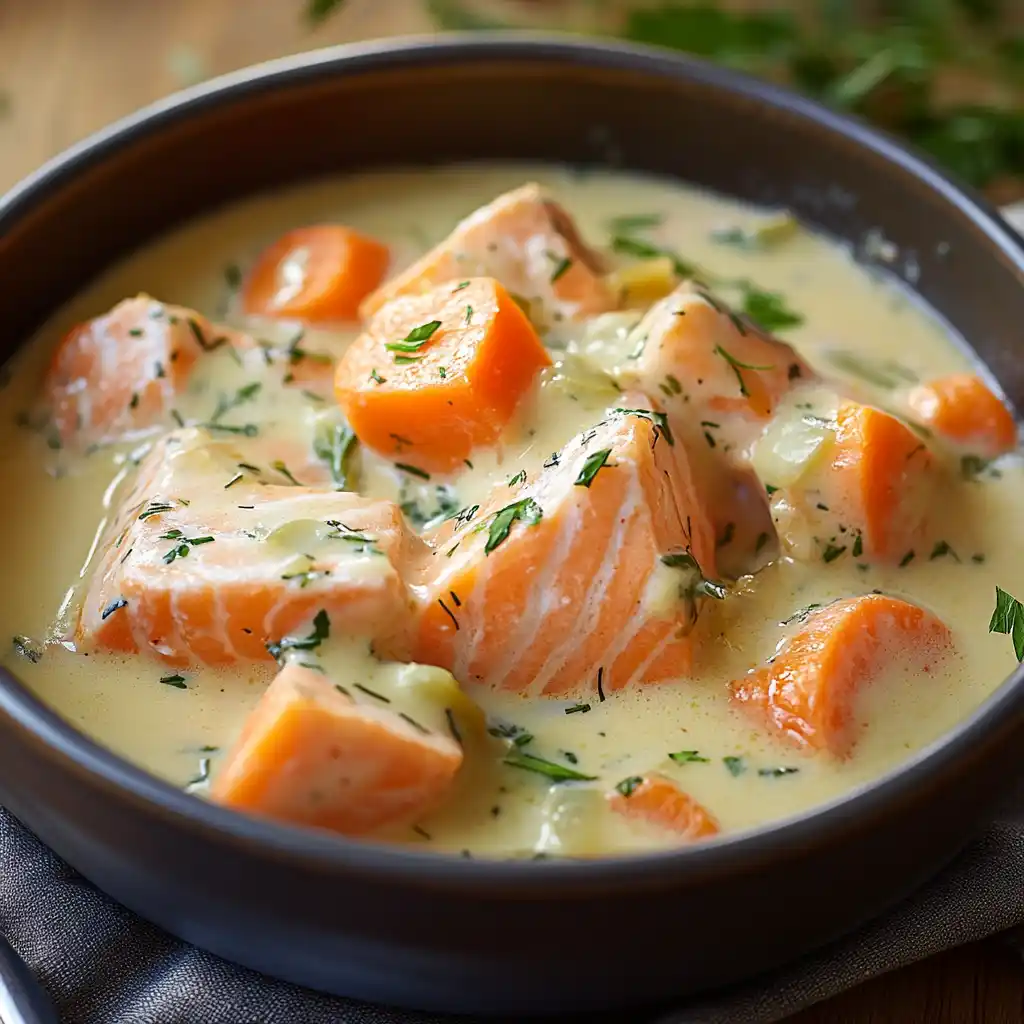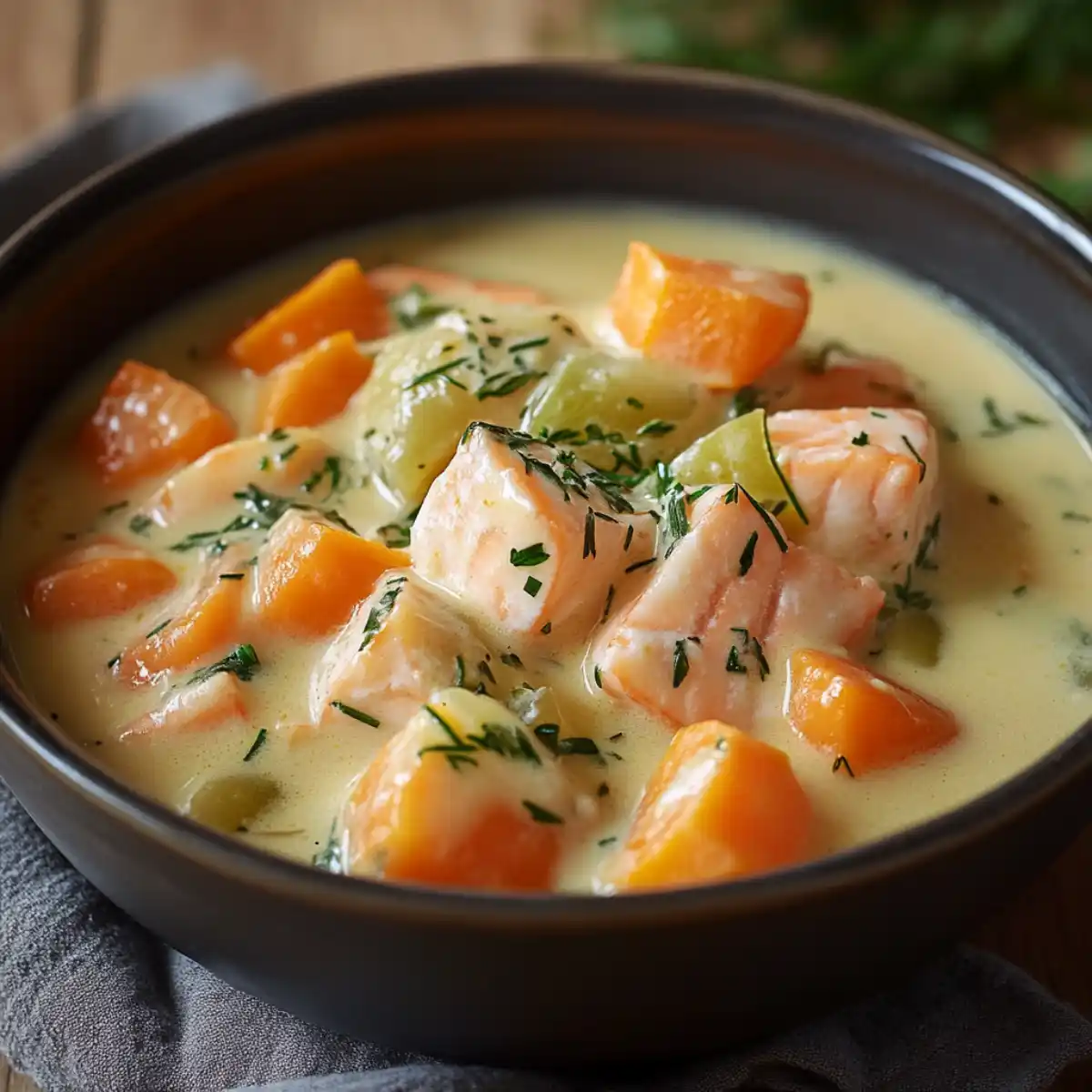
The kitchen fills with warmth as the aroma of a rich salmon chowder simmers gently on the stove. Growing up in the Pacific Northwest, seafood wasn’t just a meal—it was a cherished tradition. It connected our family through generations of coastal cooking. This creamy salmon soup is more than just a recipe; it’s a culinary embrace.
It transforms simple ingredients into a soul-warming experience.
Table of Contents
Whether you’re seeking comfort on a chilly evening or looking to impress dinner guests, this seafood bisque is perfect. Fresh salmon, velvety cream, and carefully selected seasonings come together. They create a dish that speaks directly to your appetite and heart.
Key Takeaways
- Discover a restaurant-quality creamy salmon soup you can make at home
- Learn how to select the best salmon for your chowder
- Master techniques for achieving a perfectly smooth texture
- Explore versatile variations for different dietary needs
- Understand the nutritional benefits of homemade seafood soup
Understanding the Perfect Creamy Salmon Soup
Explore the world of fish soup recipes that turn simple ingredients into a masterpiece. Creamy seafood soup has a long history, bringing warmth and comfort to all who taste it.

Origins of Salmon Soup
Salmon chowder started in coastal areas where seafood was plentiful. Fishermen and their families made these hearty soups to use their catch. It became a favorite in New England, where sea traditions are strong.
“A good salmon soup tells a story of tradition, survival, and culinary creativity.” – Coastal Cuisine Experts
Benefits of Making Homemade Fish Soup
- Control over ingredient quality
- Reduced sodium and preservatives
- Customizable flavor profiles
- Cost-effective meal preparation
- Nutritional powerhouse with omega-3 rich salmon
Key Components of a Great Salmon Chowder
| Component | Importance | Recommended Quality |
|---|---|---|
| Fresh Salmon | Primary Flavor | Wild-caught, sustainably sourced |
| Cream Base | Texture | Heavy cream or half-and-half |
| Vegetables | Depth of Flavor | Fresh, seasonal produce |
| Seasonings | Taste Enhancement | Fresh herbs, sea salt, white pepper |
To make the perfect salmon chowder, you need to know these key elements. Each part is vital for a rich, creamy seafood soup that will please your taste buds.
Essential Ingredients for Your Salmon Chowder
Making a tasty salmon soup with potatoes begins with picking the right ingredients. Your chowder recipe needs specific parts that blend to create deep, comforting tastes.

The base of a fantastic salmon soup with dill is top-notch ingredients. Let’s look at the main pieces that turn a basic dish into a memorable one.
Core Ingredients
- Fresh salmon (preferably wild-caught)
- Russet or Yukon Gold potatoes
- Heavy cream or half-and-half
- Fresh dill
- Butter
- White onions
Flavor Enhancers
| Ingredient | Purpose | Recommended Quantity |
|---|---|---|
| Fresh Dill | Adds bright, herbal notes | 2-3 tablespoons, chopped |
| Garlic | Provides depth and aroma | 2-3 minced cloves |
| White Wine | Enhances overall complexity | 1/4 cup |
“The secret to an exceptional chowder recipe is balancing fresh ingredients with thoughtful preparation.” – Professional Chef
Choose fresh, wild-caught salmon for the best taste and texture. Pick waxy, firm potatoes to keep their shape while cooking.
Optional Ingredient Variations
- Smoked salmon for deeper flavor
- Leeks instead of traditional onions
- Different herb combinations
Pro tip: Always use fresh dill for the most vibrant taste in your salmon soup with potatoes.
Kitchen Tools and Equipment Needed
Making a simple soup like salmon chowder needs the right tools. The right equipment makes cooking easy and fun. It turns a tough task into a breeze.
Essential Cooking Utensils
Start your salmon soup journey with the right tools. Here are the must-haves for a tasty fish chowder:
- Large heavy-bottomed pot or Dutch oven
- Sharp chef’s knife for precise ingredient preparation
- Cutting board
- Wooden spoon for stirring
- Measuring cups and spoons
- Ladle for serving
Helpful Kitchen Gadgets
These optional tools can make your soup prep easier:
- Immersion blender for smooth texture
- Digital kitchen scale for precise ingredient measurements
- Food processor for quick vegetable chopping
- Instant-read thermometer
Selecting the Perfect Pot
Choosing the right pot is key for a healthy soup like fish chowder. Look for a pot with:
- Thick, heavy bottom for even heat distribution
- Minimum capacity of 4-6 quarts
- Sturdy handles
- Tight-fitting lid
“The right tools can turn a good recipe into an extraordinary meal.” – Professional Chef
Quality kitchen equipment ensures your fish chowder is always creamy and delicious.
Selecting the Best Salmon for Your Soup
Making the perfect salmon soup begins with picking the right fish. Not all salmon is the same, and your choice greatly affects your soup’s taste. Knowing the differences in salmon varieties can make your soup go from good to great.
- Freshness is key for tasty soup recipes
- Wild-caught salmon has a stronger flavor
- Choosing sustainable fishing helps taste and the planet
Different salmon types add special qualities to your soup:
| Salmon Variety | Flavor Profile | Best for Soup |
|---|---|---|
| Sockeye | Rich, intense | Hearty, flavorful soups |
| Coho | Mild, delicate | Lighter, creamy soups |
| King (Chinook) | Buttery, luxurious | Premium soup recipes |
“The quality of your salmon defines the soul of your soup.” – Professional Chef
Pro tip for quick soup adventures: If fresh salmon isn’t available, high-quality frozen salmon is a great choice. Look for individually vacuum-sealed portions to keep the flavor and texture best.
If you can’t find salmon or have dietary restrictions, try cod or halibut. They offer similar health benefits and taste great in soups.
Step-by-Step Preparation Guide
Making a tasty healthy salmon soup is easy. This guide will show you how to make a creamy salmon soup. It’s both healthy and simple to make.
Preparing the Salmon
Choose high-quality salmon for your soup. Fresh or frozen salmon is perfect. Here’s how to prepare it:
- Remove skin and bones from salmon fillet
- Cut salmon into bite-sized cubes (approximately 1-inch pieces)
- Pat salmon dry with paper towels to ensure better seasoning absorption
Creating the Base
The base of your easy salmon soup sets its flavor. Here’s a quick way to make a rich base:
- Melt butter in a large pot over medium heat
- Sauté minced garlic and onions until translucent
- Add flour to create a roux for thickening
- Slowly add chicken or vegetable broth
Adding Vegetables and Seasonings
Add vegetables and seasonings to make your soup better:
| Vegetable | Preparation | Cooking Time |
|---|---|---|
| Potatoes | Diced small | 10-12 minutes |
| Carrots | Sliced thin | 5-7 minutes |
| Celery | Chopped | 3-5 minutes |
Use dill, parsley, salt, and white pepper for flavor. Add salmon cubes in the last 5-7 minutes to avoid overcooking.
Pro tip: For a creamier texture, add heavy cream or half-and-half in the final minutes of cooking.
Tips for Achieving the Perfect Creamy Texture
Making the perfect creamy seafood soup is more than just mixing ingredients. It takes precision and technique to get that smooth, velvety feel. This is what makes fish soup recipes so appealing.
The key to a creamy texture is knowing how ingredients work together. Starch and fat are your main helpers in making a rich, smooth base for your salmon chowder.
- Use heavy cream or half-and-half for maximum richness
- Incorporate cornstarch or flour as natural thickening agents
- Blend a portion of potatoes to create natural creaminess
- Simmer slowly to allow ingredients to meld together
“Patience is the key to transforming simple ingredients into a decadent creamy seafood soup.” – Professional Chef
To start your salmon chowder, make a roux. This is a mix of butter and flour that gives a silky base. Slowly add your liquids while whisking to avoid lumps. Don’t boil, as it can ruin the texture.
Pro tip: If your soup is too thick, add warm fish stock or cream. If it’s too thin, mix cornstarch with cold water and stir it into the soup while it’s simmering.
Dairy-Free and Healthy Variations
Making a dairy-free salmon soup doesn’t mean losing flavor or creaminess. Smart swaps can turn your classic recipe into a healthy, diet-friendly soup.
Dietary limits shouldn’t stop you from enjoying a tasty salmon soup. We’ll look at some healthy swaps that keep your soup delicious and nutritious.
Coconut Milk Alternative
Coconut milk is a creamy base for those who prefer dairy-free soups. Its sweetness pairs well with salmon, adding a luxurious feel. Just swap heavy cream with full-fat coconut milk for a creamy, dairy-free soup.
- Use unsweetened coconut milk for best results
- Select full-fat versions for maximum creaminess
- Balance coconut flavor with herbs like dill or parsley
Low-Calorie Options
Lowering calories in your salmon soup doesn’t mean it has to taste bad. Try these light changes:
- Replace cream with low-fat milk or broth
- Add more vegetables for volume
- Use lean salmon cuts
Gluten-Free Modifications
Make your salmon soup gluten-free with simple swaps:
| Traditional Ingredient | Gluten-Free Replacement |
|---|---|
| Wheat flour | Cornstarch or arrowroot |
| Regular crackers | Gluten-free crackers |
| Standard roux | Potato starch thickener |
“Healthy eating is about making smart, sustainable choices that nourish your body.” – Nutrition Expert
With these changes, you’ll have a versatile salmon soup that fits many diets. It will still taste great and be good for you.
Common Mistakes to Avoid
Making the perfect salmon soup with potatoes can be challenging. Even skilled cooks can face issues. Knowing the common mistakes helps you make a dish to remember.
Salmon is a delicate fish that needs careful handling. A big mistake is overcooking the salmon, making it tough and dry. The key is to add salmon towards the end of cooking and gently poach it in the soup base.
- Avoid using frozen salmon that hasn’t been properly thawed
- Select fresh, high-quality salmon for the best flavor
- Cut salmon into uniform chunks to ensure even cooking
When making salmon soup with dill, many add too much or too little seasoning. Dill should complement the salmon’s flavor, not overpower it. Start with a small amount and adjust to taste.
“Cooking is about precision and passion – respect your ingredients.” – Professional Chef
Choosing the right potatoes is key in your chowder recipe. Waxy potatoes like Yukon Gold are best because they keep their shape and add creaminess. Avoid starchy potatoes that can make your soup gummy or fall apart.
- Dice potatoes into consistent, small cubes
- Pre-cook potatoes slightly before adding to the soup
- Choose potatoes that complement the salmon’s rich flavor
By understanding these common mistakes, you’ll be well on your way to creating a spectacular salmon soup. It will surely impress your family and friends.
Serving Suggestions and Garnishes
Turning your fish chowder into a special meal is all about how you present it. The right touches can make your healthy soup a feast for the senses. It’s not just about taste; it’s about the whole experience.
Perfect Side Dishes
Choosing the right sides can really boost your salmon soup’s taste. Here are some tasty ideas:
- Crusty artisan sourdough bread
- Crisp green salad with lemon vinaigrette
- Roasted garlic herb focaccia
- Fresh herb-crusted croutons
Wine Pairing Recommendations
Finding the perfect wine can make your fish chowder even better. Light to medium-bodied white wines pair well with salmon:
- Sauvignon Blanc: Its crisp acidity balances the creamy soup
- Pinot Grigio: It brings out the seafood flavors nicely
- Unoaked Chardonnay: Smooth and complements the rich soup
“A great wine pairing can transform a simple meal into an extraordinary culinary journey.” – Culinary Institute of America
With the right garnishes and sides, your easy soup becomes a gourmet dish. It will impress everyone at your table.
Storage and Reheating Guidelines
Keeping your quick soup fresh is key to enjoying salmon recipes all week. The right storage keeps your creamy salmon soup safe and delicious.
Refrigeration Basics
Put your salmon soup in an airtight container in the fridge. It’s best to eat it within 3-4 days. Cool it down first to stop bacteria from growing.
- Use glass or ceramic containers with tight-fitting lids
- Keep soup at or below 40°F (4°C)
- Avoid storing soup with additional garnishes
Freezing Your Soup
Freezing is a great way to keep your soup fresh longer. It can stay good for 2-3 months if frozen right.
| Storage Method | Maximum Storage Time | Best Practices |
|---|---|---|
| Refrigerator | 3-4 days | Use airtight container |
| Freezer | 2-3 months | Leave 1-inch space for expansion |
Reheating Tips
To get your soup creamy again, heat it up slowly. Use low to medium heat and stir often to avoid lumps.
- Thaw frozen soup in refrigerator overnight
- Heat on stovetop over medium-low heat
- Stir occasionally to maintain consistent temperature
- Add a splash of milk if soup appears too thick
“The secret to great reheated soup is patience and gentle heating.” – Professional Chef
Pro tip: Never reheat salmon soup multiple times, as this can degrade quality and food safety.
Seasonal Adaptations and Variations
Adapting your fish soup recipes for different seasons and occasions makes your creamy seafood soup versatile. Your salmon soup can change from a light summer dish to a hearty winter comfort meal with a few tweaks.
Summer Light Version
In the summer, your seafood bisque can be a refreshing yet satisfying meal. Here are some tips:
- Replace heavy cream with light coconut milk
- Add fresh herbs like dill or basil
- Serve chilled or at room temperature
- Incorporate crisp summer vegetables like zucchini or corn
Hearty Winter Alternative
For cold winter days, make your creamy seafood soup a robust meal that warms you up:
- Use root vegetables like parsnips and carrots
- Add smoked salmon for deeper flavor
- Include hardy grains like barley or quinoa
- Increase cream content for extra richness
Special Occasion Modifications
Elevate your fish soup recipes for memorable gatherings with these touches:
| Occasion | Luxury Ingredient | Presentation Tip |
|---|---|---|
| Dinner Party | Dungeness Crab | Garnish with fresh chervil |
| Holiday Meal | King Crab Meat | Serve in elegant porcelain bowls |
| Anniversary | Lobster Chunks | Drizzle with truffle oil |
“A great soup tells a story of its ingredients and the moment it’s served.” – Unknown Chef
Flexibility and creativity are key to an exceptional seafood bisque. Each variation adds its own charm to this classic dish.
Explore Related Recipes and Tips
For more seafood and creamy dishes, check out these related recipes:
- Make Perfect Smoked Salmon Dry Brine to elevate your salmon dishes.
- Want a quick and delicious meal? Try Easy Salmon Breakfast Recipes.
- If you love seafood soup, check out Easy Creamy Salmon Soup Recipe.
Conclusion
Making a tasty creamy salmon soup is easy. This guide shows you how to make a top-notch salmon chowder at home. You’ll learn to make a dish that’s both memorable and fits your taste and diet.
Salmon soup is very flexible. You can try new ingredients and seasonings to make it your own. Whether it’s a light summer soup or a warm winter one, the basics stay the same. As you get better, you’ll find it easier to mix flavors and get that creamy feel.
It’s time to become your own chef and start making creamy salmon soup. Feel free to try new things, taste, and improve your skills. Share your cooking with others and enjoy the journey of learning. Your next great dish is just a few ingredients away.
Are you ready to make homemade salmon chowder? Your kitchen is waiting, and you’re about to make some amazing memories.
FAQ
How long can I store leftover creamy salmon soup?
Store creamy salmon soup in a sealed container in the fridge for 3-4 days. For the best taste, eat it within 2 days. Make sure it’s kept at 40°F or below.
Can I make this soup dairy-free?
Yes! Replace heavy cream with coconut milk or cashew cream for a dairy-free version. This keeps the soup creamy and rich.
What type of salmon works best for this soup?
Fresh wild-caught salmon is best. Sockeye or king salmon also work well. If fresh salmon isn’t available, frozen high-quality salmon is a good choice. Look for salmon that’s firm, bright, and smells fresh.
Is this soup gluten-free?
The basic recipe can be gluten-free. Use gluten-free flour or cornstarch as a thickener. Make sure all ingredients are gluten-free. Always check labels.
How can I make the soup healthier?
Use low-fat milk or coconut milk instead of heavy cream. Add more veggies and choose lean salmon. Reduce sodium by using low-sodium broth and controlling salt.
Can I freeze creamy salmon soup?
Freezing is possible, but dairy soups may separate when thawed. Freeze without cream and add it when reheating. Store for 2-3 months in an airtight container.
What are good side dishes to serve with salmon soup?
Great options include crusty sourdough bread, light green salad, and roasted veggies. A simple arugula salad with lemon vinaigrette also pairs well. These sides enhance the soup’s creamy texture.
How can I prevent the salmon from becoming tough?
Cook salmon gently and avoid overcooking. Add it towards the end and simmer until it’s just opaque and flakes easily. This usually takes 3-5 minutes, depending on the salmon’s thickness.
Are there any low-calorie alternatives for this soup?
Yes! Use Greek yogurt instead of cream and add more veggies. Choose a lighter fish stock and control portion sizes. Use less salmon and add more veggies to cut calories.
What wine pairs well with creamy salmon soup?
Sauvignon Blanc, Pinot Grigio, or unoaked Chardonnay are great choices. These wines complement the salmon without overpowering the soup.

